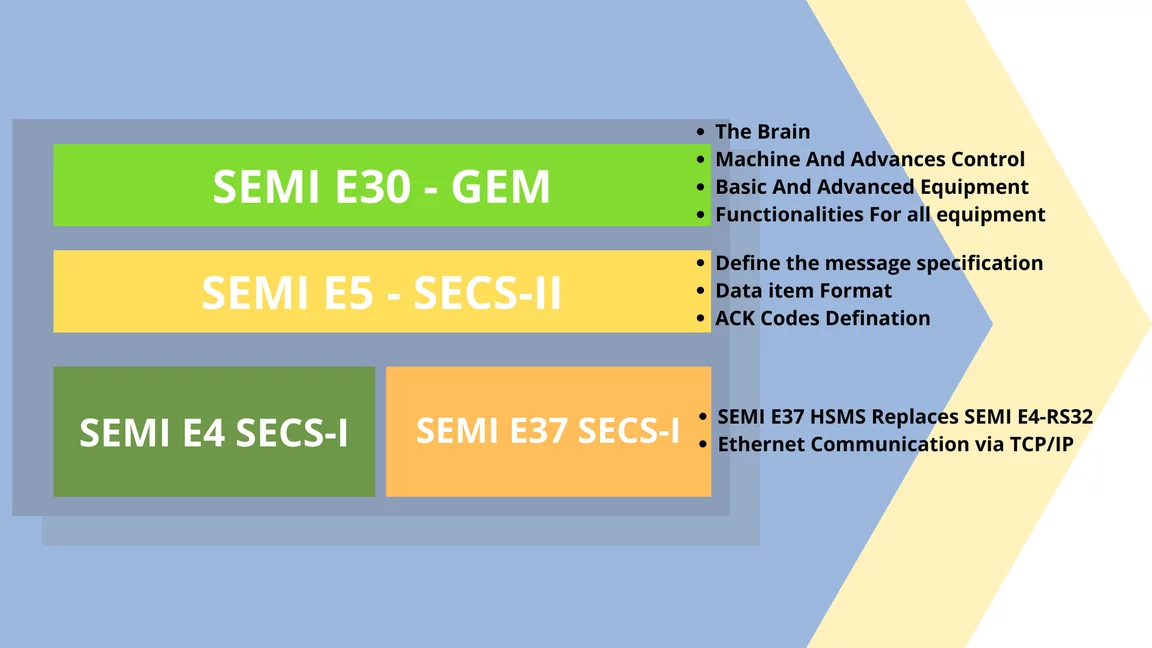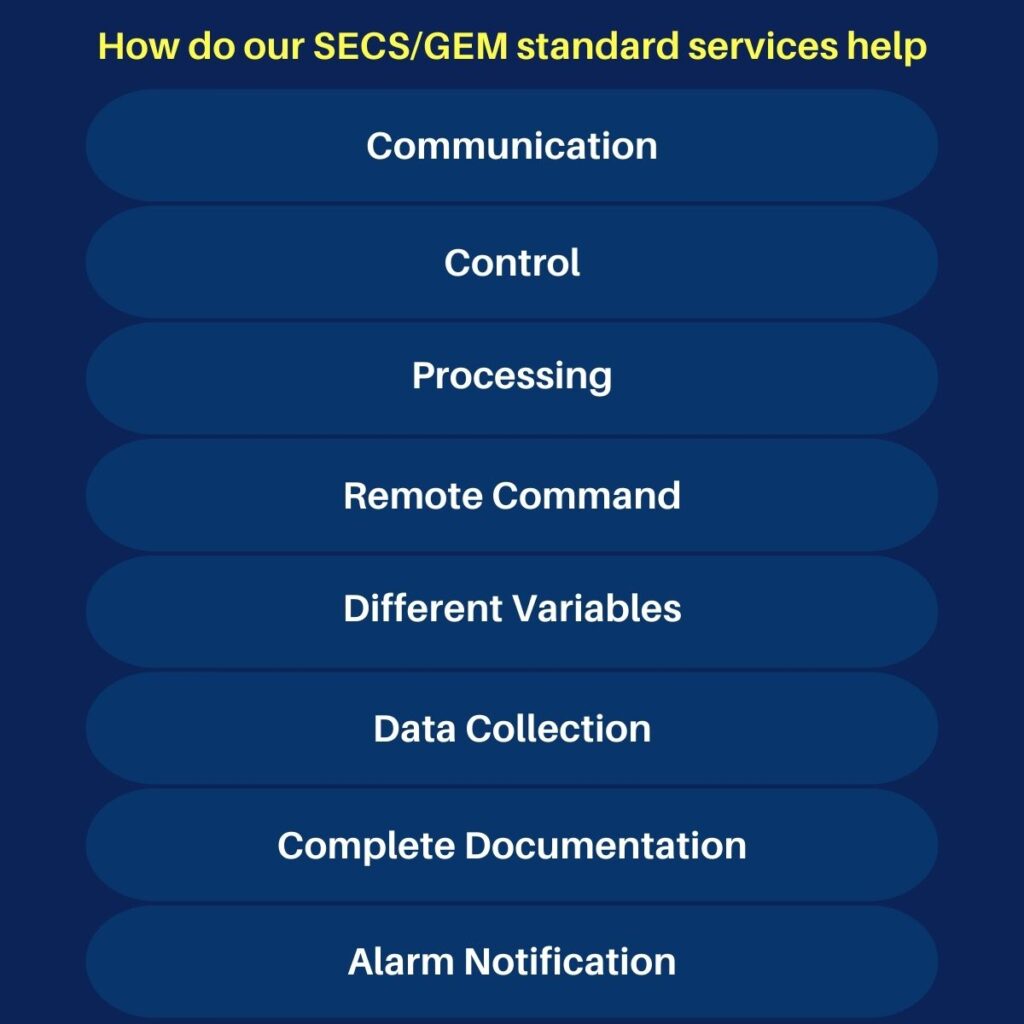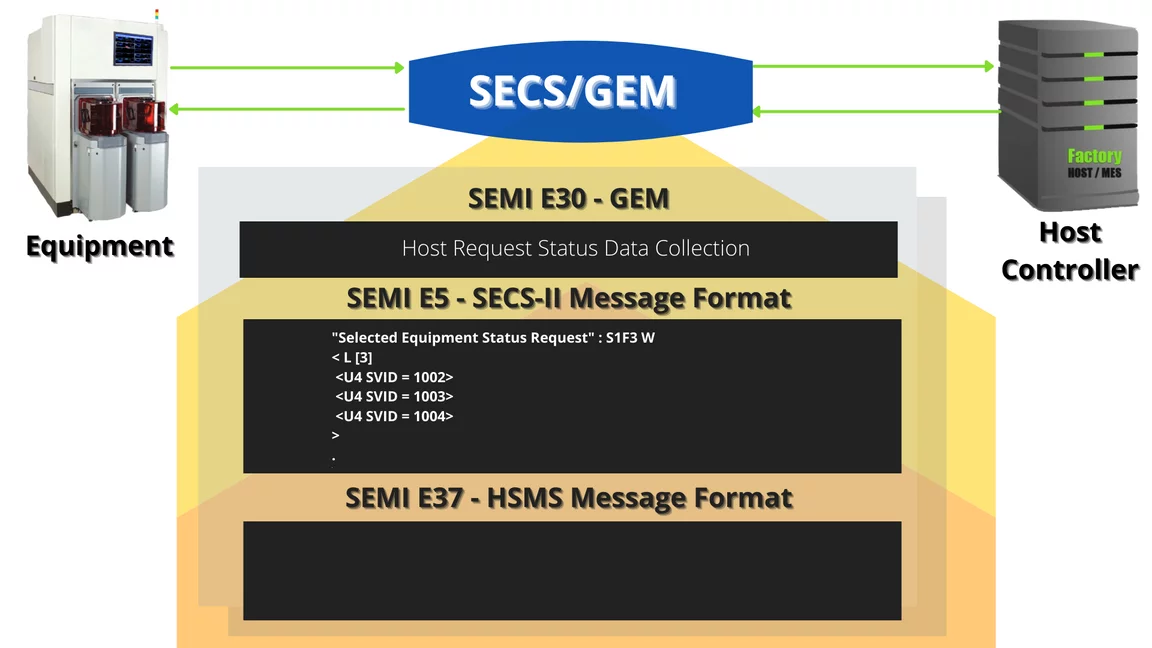SECS (SEMI Equipment Communications Standard)/GEM (Generic Equipment Model) is communication interface protocols for communication between semiconductor equipment and a fab host. Fab host is a software application that is controlling and monitors equipment processing using SECS/GEM protocol. SECS/GEM compliant equipment can communicate with the fab host using either TCP/IP (using SEMI standards E37 and E37.1 – HSMS) or RS-232 (using SEMI standard E4 – SECS-I).

The SECS/GEM standard interface is used to start as well as stop equipment processing, collect measurement data, select recipes for products, and change variables. With SECS/GEM, all this can be performed in a standard way. SECS/GEM protocol has been standardized by the non-profit association SEMI (Semiconductor Equipment and Materials International). semi.org to learn more about SEMI standards and SECS/GEM protocol.
How do our SECS/GEM standard services help?
1. Communication
Communication defines the behavior of the equipment regarding the presence or absence of a communication link with the host. It also specifies how to establish or resume communication with S1F13/S1F14 when it is cut off. Using our SECS/GEM Software, the host can have an easy communication process.
2. Control
eInnosys CONTROL state model in SECS/GEM protocol specifies the degree of collaboration between the host and the equipment. The CONTROL paradigm offers the host three fundamental degrees of host control that establish the host’s capacity to command the apparatus:
- OFFLINE (Lowest Level): The operator working in the operator console manually operates the entire equipment. The equipment will reply with an SxF0 to any direct message from the host other than S1F13 or S1F17; the equipment will reply with an SxF0.
- LOCAL/ONLINE (Middle Level): The Host is only permitted to carry out “read-only” operations in this state, such as data collecting. The host cannot change equipment constants that impact processes, remote commands that result in motion, or processing-initiating commands.
- Online/Remote: The highest level of operation is ONLINE/REMOTE, in which case the host is free to use the equipment to the fullest extent possible using the communications interface.
3. Processing
The equipment method, technology, and design all play a significant role in the PROCESSING state model. However, it is anticipated that these models will share some characteristics.
4. Remote Command
eInnosys Equipment can be given instructions from the host to carry out an automatic task. For instance, START, STOP, PAUSE, etc. The aforementioned command is comparable to the operator’s manual action on the console.
5. Different Variables
There are three different types of variables:
- Status Variable: This equipment-defined global variable is “read-only”. The apparatus updates the relevant status variable every time processing occurs to reflect the most recent information. For instance: an incremental counter, the present or past condition, etc.
- Equipment Constant: This is a global variable that can be read and written. Using the right techniques and formulas, the host can modify the constant equipment variables, impacting the settings and ultimately altering how the equipment behaves.
- Continuous Variable: This variable is “local” and only exists in collection events.

6. Data Collection
- The user can use the S1F3 command to request a collection of status variable values.
- The S2F13 command helps to obtain a list of equipment constant values.
- A report that includes status variables and data variables can be defined by the host and attached to a collection event. The report comprising the values of those variables is sent simultaneously when the equipment raises the event (using the S6F11 instruction).
- The host can provide traces that will periodically sample the status variable data.
- Utilizing alarm notifications to increase data gathering through collection events is another option. Whenever an alert occurs or is cleared, per standard, an event needs a transmission to the host.
7. Complete Documentation
Each equipment supplier needs to offer a GEM Interface Reference Manual per the SECS/GEM standard. A list of status variables, equipment constants, alarms, collection events, etc., that are defined or supported by the equipment is required, as well as a GEM Compliance declaration and complete SECS-II message documentation. EInnosys secs/gem simulator helps to stimulate equipment or the factory depending on the use case and communication.
8. Alarm Notification
With this function’s aid, the equipment can alert the host whenever an alarm or fault on the equipment occurs or is resolved. Alarms are unusual, unwelcome events that put people, property, or processed physical materials in danger.
Equipment used for working on SEMI E30
Tools must implement a minimal subset of all the capabilities listed in the E30 standard to comply with basic GEM requirements. EInnosys’ tool ideally supports remote control, data publication, and complete process management. Some functions, such as spooling (which stores tool messages for later delivery when communication between the host and the tool is down) or limitations monitoring, are less frequently requested (a simple piece of SPC-like analysis reported by the equipment). Our SECS/GEM connectivity devices offer full compliance for every capability stated in the SEMI E30 standard, regardless of what a specific fab asks your tools to support.

In simple words, the SECS/GEM standard defines messages, state machines, and scenarios to enable factory host applications to control as well as monitor manufacturing equipment. GEM standard is officially designated as SEMI standard E30 but is frequently referred to as the GEM or SECS/GEM standard. The GEM is beneficial for both device manufacturers and equipment suppliers as it defines a common set of equipment behavior and communication capabilities to provide functionality as well as the flexibility to support manufacturing. Since the GEM standard has only a few semiconductor-specific features, it has been adopted by other manufacturing industries as well, such as PV.
SEMI Standards:
E30
Specification for the Generic Model for Communications and Control of Manufacturing Equipment (GEM)
E5
Specification for SEMI Equipment Communications Standard 2 Message Content (SECS-II)
E37
Specification for High-Speed SECS Message Services (HSMS) Generic Services
E4
Specification for High-Speed SECS Message Services (HSMS) Generic Services
Among the capabilities offered by the SECS/GEM standard is –
- For a fab host to start and stop processing
- For a fab host to select, download, and upload recipes from/to the equipment
- For a fab host to query the equipment for values of various process parameters and equipment configuration
- For a fab host to set equipment configuration parameter values
- For equipment to send alarms to the fab host
- For a fab host to define reports of various variables and associate them with events such as lot start or
wafer complete - For equipment to send various events and associated reports to the fab host
Since SECS/GEM is a communication protocol, it is platform and technology as well as programming language independent. The host side of a connection is executing on a computer system provided by the factory, and the equipment side of a connection is running on a controller computer provided by the equipment manufacturer. This gives both – the fab as well as the equipment manufacturer interoperability, flexibility, and platform independence. Both, the fab and the OEM can develop their software application without having to worry about communication compatibility, as long as both of them are adhering to SECS/GEM standards.
Best Offers for SECS/GEM Software Solutions
eInnoSys offers SECS/GEM software solutions for equipment manufacturers (OEMs) as well as factories (FABs or ATMs). By integrating eInnoSys’ EIGEMEquipment plug-n-play software with equipment controller software of equipment, OEMs can significantly reduce the cost and time it takes to make their equipment SECS/GEM capable. Likewise, EIGEMHost is a SECS/GEM software for FABs and ATMs (Assembly and Test Manufacturing) to communicate with various equipment in the factory. EIGEMSim is a simulator software for SECS/GEM testing. It is software that can be configured as a host or equipment to test SECS/GEM communication of the other.
SECS describes the communication between a host computer and the equipment using a single connection. In the original concept and even today in the most common scenario, the equipment provides a single SECS interface for exclusive use by a single host. The message types defined by SECS are partially asymmetric – some message types are defined only for host use, others are defined only for equipment, but also many of them are defined for the same use by either side.
However, there is a provision in the SECS standards for sharing a connection by specifying the device identification value in each message. The practice of connection sharing is not recommended for new deployments. It is a common practice that a connection is maintained for long periods of time and only interrupted if the equipment or host is rebooted. SECS connections are lightweight and don’t use much network bandwidth. It is possible to run several SECS connections on a typical desktop computer.


